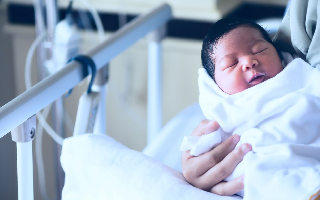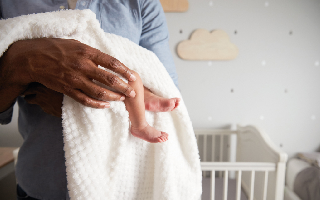
- No win. No fee.
- No hidden costs
- 100% risk-free, only pay if you win
- Home >
- Insights >
- Birth Injuries >
- Cerebral Palsy – 8 commonly asked questions
About the Author
Tami Frankel
Medical Negligence Solicitor and Partner - LLB (Hons) University College London
Read more about Tami »When you become a parent, be it for the first time or the fifth time, you expect your life to change. New routines. New responsibilities. New experiences. However, for parents of a child born with Cerebral Palsy, this change can be significantly more challenging.
It is estimated that 1 in 400 children are born with Cerebral Palsy, and approximately 1,800 are diagnosed every year. And while the severity and outcomes of this diagnosis will vary from child to child, it is likely to influence what care they require and how they live for the rest of their life.
If you are unfamiliar with Cerebral Palsy, it is understandable that you may have many questions about the condition itself and what it means for your child’s future. In this article we will answer 8 of the most frequently asked questions, from the causes and symptoms of Cerebral Palsy through to initiating birth injury claims if the condition is the result of medical negligence.
Cerebral Palsy – 8 commonly asked questions
- 1. What is Cerebral Palsy?
- 2. What can cause Cerebral Palsy?
- 3. Is Cerebral Palsy permanent?
- 4. Does Cerebral Palsy get worse over time?
- 5. What are treatment options for Cerebral Palsy?
- 6. What equipment will my child need?
- 7. What does the future hold for my child and family?
- 8. What difference can compensation make?
1. What is Cerebral Palsy?
The term Cerebral Palsy describes a group of conditions caused by an injury to a baby’s developing brain, occurring before, during or shortly after delivery.
As a neurological injury, it typically affects a person’s movement, coordination and posture. This means they are likely to have problems with their mobility and motor control. In addition, they may experience learning difficulties or developmental delays, as well as one or more of a number of other problems including difficulty with swallowing and communication.
The effects of Cerebral Palsy can include:
Delay in reaching developmental milestones such as sitting up or walking
Stiff or floppy limbs
Weakness in the arms and/or legs
Fidgety, jerky, clumsy or random movements
Difficulty with walking
Difficulty with swallowing
Problems with vision
Difficulty with communication
Which effects are present and the severity of those that are present will depend on the nature of the brain injury suffered. Some children with Cerebral Palsy are less affected whereas others will be severely disabled and require around-the-clock care.
Different types of Cerebral Palsy include:
Spastic Hemiplegia
Spastic Diplegia
Ataxic Cerebral Palsy
Athetoid (Dyskinetic) Cerebral Palsy
Spastic Quadriplegia
For more information on the types of Cerebral Palsy, we recommend reading more on the NHS website.
2. What can cause Cerebral Palsy?
Cerebral Palsy can be caused when a baby suffers a brain injury before, during or shortly after birth.
If it occurs in the womb, this is often due to a lack of oxygen or blood reaching the baby’s brain. It might also develop as a result of the baby suffering a stroke, or if the mother contracts an infection such as rubella or chickenpox whilst pregnant.
During or following the birth, Cerebral Palsy can be caused by the baby temporarily being oxygen deprived, suffering a head injury, suffering a stroke or contracting meningitis, or another brain infection.
While brain injury can occur even if all medical procedures and protocols are followed closely, there are occasions when it occurs as a result of negligence by a doctor, nurse, midwife, obstetrician or another healthcare professional.
There are a number of risk factors that increase the likelihood of a child being born with Cerebral Palsy:
Prematurity (being delivered before 37 weeks)
Difficult birth
Multiple births
The mother’s age (either under 20 or over 40)
Exposure to substances like alcohol or nicotine in the womb
4. Does Cerebral Palsy get worse over time?
Cerebral Palsy is a non-progressive condition, meaning the brain damage caused by the initial injury will not worsen or spread to other areas over time.
However, as someone with Cerebral Palsy ages, their care and support requirements might change. For example, if they frequently fidget, walk on tiptoes or have stiff limbs, this may result in them experiencing joint and bone problems in later life which may then require surgery or other procedures.
5. What are treatment options for Cerebral Palsy?
As someone with Cerebral Palsy’s needs can change over time, the care plan devised for your child by their healthcare professionals must be regularly reviewed and updated.
The range of healthcare professionals who may be involved in formulating a care plan and treating your child include:
- Paediatricians
- Nurses
- Carers
- Physiotherapists
- Dietitians
- Speech and language therapists
- Occupational therapists
- Psychologists
- Educational psychologists
- Social workers
Treatments that can help people manage their symptoms of Cerebral Palsy and live as comfortable, independent lives as possible include:
- Physiotherapy: This will help to encourage movement, improve muscle strength, and prevent muscles from shortening.
- Speech and language therapy: Providing exercises to practise speech or teach alternative forms of communication, like sign language or using pictures. It can also help with swallowing.
- Occupational therapy: Advising on ways to help your child approach everyday tasks with complex movements, like going to the toilet or getting dressed, to help improve their independence and self-esteem.
- Managing feeding problems: Teaching swallowing techniques and advising on dietary changes to help those with difficulty swallowing food.
- Medicines: A range of medicines can be prescribed to help someone with Cerebral Palsy deal with muscle stiffness, sleeping difficulties, excessive drooling, epilepsy, constipation, pain and other issues they may experience.
- Surgery: Operations may be performed to restore movement to parts of the body, make walking easier, repair hip dislocations and correct instances of scoliosis (curvature of the spine).
If your child’s Cerebral Palsy was due to the negligence of one or more healthcare professionals, the compensation you receive from a successful birth injury claim can help to cover the costs of these treatments throughout their life.
6. What equipment will my child need?
In addition to a range of treatments, someone with Cerebral Palsy may benefit from a variety of equipment to support their movement, communication and overall quality of life.
This may include:
Wheelchairs, scooters or walking aids, such as walking frames, walking sticks, arm and leg braces, AFOs and specialist footwear
Communication devices such as symbol boards, voice synthesizers, and headsticks and keyguards for computers
Electronic door openers
Large-handled eating utensils and grab sticks
Adaptations to accommodation, such as the introduction of lifts or stairlifts, wet rooms, hoist systems and ramps
7. What does the future hold for my child and family?
We find this is often the most pressing question for parents after their child is diagnosed with Cerebral Palsy. Parents will often worry about who will care for their child as they themselves age.
It is undoubtedly a time of uncertainty, but the fact is that everyone’s experience of Cerebral Palsy is different. Some will be relatively unhindered by the condition, while others will be entirely dependent on the support of others.
Here are some statistics that offer a general idea of what you could expect following a diagnosis:
- One in three children will not be able to walk
- One in four children will be unable to feed or dress themselves
- One in four children has a severe learning disability
- One in ten children will have no useful vision, while one in eleven is blind
- One in fifty children will be deaf
- One in four children will have epileptic seizures
As a result, it is possible that adaptations will be required to the home to allow for the access for a wheelchair, hoist system, carers room, therapy room and storage of items such as mobility aids, therapy mats and feed. If the home cannot be suitably adapted, then a move to another property which can be suitably adapted may be necessary.
The child may require help with some or all of daily activities and care. They may attend a school which is able to focus on their needs and may need someone to make decisions for their health and benefit throughout their lifetime.
If the effects of their Cerebral Palsy are significant, it is likely that the child will need to receive care for the remainder of their life. This means that parents, guardians and other loved ones often worry about what will happen when they are unable to provide this themselves.
This makes the need for a clear care plan, backed by trusted healthcare professionals and the right equipment, essential in ensuring that the child is looked after and supported into adulthood and beyond.
It should not be overlooked that Cerebral Palsy not only affects the child, but their parents, siblings, other family members and friends. These people will also have their lives altered dramatically in order to provide the care and support that the child with Cerebral Palsy needs.
If your child has brothers or sisters, it is important to balance care and attention between them, and help them understand their sibling’s condition:
- Be honest when they ask questions
- Teach them the correct vocabulary and terms associated with Cerebral Palsy
- Get their schools involved to support their own wellbeing
8. What difference can compensation make?
A Cerebral Palsy diagnosis has life-changing implications for both the person affected and their loved ones. Compensation can help to provide all of the things that your child will need throughout their life.
It will allow them to access the care and therapies they need and will provide you with peace of mind that they will be properly looked after even as you age. So, if your child has Cerebral Palsy which was entirely preventable or made worse as a result of the negligence of the healthcare professionals, they are entitled to justice and compensation.
Negligence causing Cerebral Palsy can range from overlooking a clear sign that something was wrong during pregnancy, to mishandling the birth, to treatment in the period soon after birth. There are numerous scenarios where the unreasonable actions or inactions of the doctors, nurses or midwives may cause or contribute to the development of Cerebral Palsy and the impact that will have on the whole of the child’s life.
Our team at Gadsby Wicks are highly experienced in helping families make birth injury claims that secure the financial support they need to move forward and give their child the best possible quality of life in the long term. The compensation your child receives can cover the costs of:
- Making necessary adaptations to the family home, or purchasing a new home entirely if the current one is unable to be adapted
- Purchase, maintain and replace equipment for the child as they get older
- Professional carers who can take the burden off of parents, allowing them to spend time with their other children and to look after themselves as well as providing much-needed care for the child
- Professional therapies and treatments
- Loss of earnings that parents incur
- A professional Deputy to manage the compensation awarded
We hope that the answers in this article have helped to clear up some of the confusion or uncertainty about Cerebral Palsy for you or a loved one.
It is entirely possible for someone with Cerebral Palsy to live a happy, fulfilling life in spite of the challenges it presents. However, much of that can depend on the compensation that you receive which will help to minimise the impact and empower those affected.
Our specialist medical negligence solicitors give your birth injury claim all the attention it needs to determine the amount of compensation you deserve, and build watertight cases to ensure you are granted the maximum amount possible.
Get in touch with us today so we can pursue your right to justice.
Disclaimer
All content contained within this article is meant for general information only – this should not be treated as a substitute for medical advice from your doctor or another healthcare provider. If you require legal advice specific to your situation, please contact our team directly.
Gadsby Wicks is not liable for any diagnosis made from the content of this article, nor does it endorse any service or external site linked to within the article.
Always consult your GP if you are concerned about your health and wellbeing, or speak to us if you require legal advice.





 Back to top
Back to top

